Exploring New Redshift Indicators for Radio-Powerful AGN
Abstract
1. Introduction
2. Materials and Methods
2.1. Data
2.2. Methods
2.2.1. Data Preparation
2.2.2. Model Selection and Stacking
3. Results
3.1. Redshift Prediction
3.2. Prediction in Stripe 82 Field
4. Discussion
4.1. Previous Results
4.2. Feature Importances
4.3. Shapley Explanations
5. Conclusions
Author Contributions
Funding
Institutional Review Board Statement
Informed Consent Statement
Data Availability Statement
Acknowledgments
Conflicts of Interest
Abbreviations
| AGN | Active Galactic Nuclei |
| QSO | Quasi Stellar Object |
| ML | Machine Learning |
| RG | Radio Galaxy |
| EoR | Epoch of Reionisation |
| CW | CatWISE2020 Catalogue |
| AW | AllWISE Catalogue |
| 1 | http://quasars.org/milliquas.htm (accessed on 3 May 2021). |
| 2 | http://quasars.org/Milliquas-ReadMe.txt (accessed on 25 October 2021). |
| 3 | https://pycaret.org (accessed on 23 October 2021). |
| 4 | https://github.com/slundberg/shap (accessed on 18 October 2021). |
| 5 | https://lofar-surveys.org/ (accessed on 3 August 2021). |
| 6 | https://www.astropy.org (accessed on 23 July 2021). |
| 7 | http://www.star.bris.ac.uk/~mbt/topcat/ (accessed on 29 July 2021). |
References
- Padovani, P.; Alexander, D.M.; Assef, R.J.; De Marco, B.; Giommi, P.; Hickox, R.C.; Richards, G.T.; Smolčić, V.; Hatziminaoglou, E.; Mainieri, V.; et al. Active galactic nuclei: What’s in a name? Astron. Astrophys. Rev. 2017, 25, 2. [Google Scholar] [CrossRef]
- Heckman, T.M.; Best, P.N. The Coevolution of Galaxies and Supermassive Black Holes: Insights from Surveys of the Contemporary Universe. Annu. Rev. Astron. Astrophys. 2014, 52, 589–660. [Google Scholar] [CrossRef]
- McGreer, I.D.; Becker, R.H.; Helfand, D.J.; White, R.L. Discovery of a z = 6.1 Radio-Loud Quasar in the NOAO Deep Wide Field Survey. Astrophys. J. 2006, 652, 157–162. [Google Scholar] [CrossRef]
- Kuźmicz, A.; Jamrozy, M. Giant Radio Quasars: Sample and Basic Properties. Astrophys. J. 2021, 253, 25. [Google Scholar] [CrossRef]
- Delhaize, J.; Heywood, I.; Prescott, M.; Jarvis, M.J.; Delvecchio, I.; Whittam, I.H.; White, S.V.; Hardcastle, M.J.; Hale, C.L.; Afonso, J.; et al. MIGHTEE: Are giant radio galaxies more common than we thought? Mon. Not. R. Astron. Soc. 2021, 501, 3833–3845. [Google Scholar] [CrossRef]
- Lal, D.V. The Discovery of a Remnant Radio Galaxy in A2065 Using GMRT. Astrophys. J. 2021, 915, 126. [Google Scholar] [CrossRef]
- Amarantidis, S.; Afonso, J.; Messias, H.; Henriques, B.; Griffin, A.; Lacey, C.; Lagos, C.d.P.; Gonzalez-Perez, V.; Dubois, Y.; Volonteri, M.; et al. The first supermassive black holes: Indications from models for future observations. Mon. Not. R. Astron. Soc. 2019, 485, 2694–2709. [Google Scholar] [CrossRef]
- Thomas, N.; Davé, R.; Jarvis, M.J.; Anglés-Alcázar, D. The radio galaxy population in the SIMBA simulations. Mon. Not. R. Astron. Soc. 2021, 503, 3492–3509. [Google Scholar] [CrossRef]
- Bonaldi, A.; Bonato, M.; Galluzzi, V.; Harrison, I.; Massardi, M.; Kay, S.; De Zotti, G.; Brown, M.L. The Tiered Radio Extragalactic Continuum Simulation (T-RECS). Mon. Not. R. Astron. Soc. 2019, 482, 2–19. [Google Scholar] [CrossRef]
- Prandoni, I.; Seymour, N. Revealing the Physics and Evolution of Galaxies and Galaxy Clusters with SKA Continuum Surveys. In Proceedings of the Advancing Astrophysics with the Square Kilometre Array (AASKA14), Giardini Naxos, Italy, 9–13 June 2014; p. 67. [Google Scholar]
- Inayoshi, K.; Visbal, E.; Haiman, Z. The Assembly of the First Massive Black Holes. Annu. Rev. Astron. Astrophys. 2020, 58, 27–97. [Google Scholar] [CrossRef]
- Ross, N.P.; Cross, N.J.G. The near and mid-infrared photometric properties of known redshift z ≥ 5 quasars. Mon. Not. R. Astron. Soc. 2020, 494, 789–803. [Google Scholar] [CrossRef]
- Miley, G.; De Breuck, C. Distant radio galaxies and their environments. Astron. Astrophys. Rev. 2008, 15, 67–144. [Google Scholar] [CrossRef]
- Helfand, D.J.; White, R.L.; Becker, R.H. The Last of FIRST: The Final Catalog and Source Identifications. Astrophys. J. 2015, 801, 26. [Google Scholar] [CrossRef]
- Norris, R.P.; Hopkins, A.M.; Afonso, J.; Brown, S.; Condon, J.J.; Dunne, L.; Feain, I.; Hollow, R.; Jarvis, M.; Johnston-Hollitt, M.; et al. EMU: Evolutionary Map of the Universe. Publ. Astron. Soc. Aust. 2011, 28, 215–248. [Google Scholar] [CrossRef]
- Gordon, Y.A.; Boyce, M.M.; O’Dea, C.P.; Rudnick, L.; Andernach, H.; Vantyghem, A.N.; Baum, S.A.; Bui, J.P.; Dionyssiou, M. A Catalog of Very Large Array Sky Survey Epoch 1 Quick Look Components, Sources, and Host Identifications. Res. Notes Am. Astron. Soc. 2020, 4, 175. [Google Scholar] [CrossRef]
- Shimwell, T.W.; Tasse, C.; Hardcastle, M.J.; Mechev, A.P.; Williams, W.L.; Best, P.N.; Röttgering, H.J.A.; Callingham, J.R.; Dijkema, T.J.; de Gasperin, F.; et al. The LOFAR Two-metre Sky Survey. II. First data release. Astron. Astrophys. 2019, 622, A1. [Google Scholar] [CrossRef]
- Singh, V.; Beelen, A.; Wadadekar, Y.; Sirothia, S.; Ishwara-Chandra, C.H.; Basu, A.; Omont, A.; McAlpine, K.; Ivison, R.J.; Oliver, S.; et al. Multiwavelength characterization of faint ultra steep spectrum radio sources: A search for high-redshift radio galaxies. Astron. Astrophys. 2014, 569, A52. [Google Scholar] [CrossRef]
- Williams, W.L.; Calistro Rivera, G.; Best, P.N.; Hardcastle, M.J.; Röttgering, H.J.A.; Duncan, K.J.; de Gasperin, F.; Jarvis, M.J.; Miley, G.K.; Mahony, E.K.; et al. LOFAR-Boötes: Properties of high- and low-excitation radio galaxies at 0.5 < z < 2.0. Mon. Not. R. Astron. Soc. 2018, 475, 3429–3452. [Google Scholar] [CrossRef]
- Capetti, A.; Brienza, M.; Baldi, R.D.; Giovannini, G.; Morganti, R.; Hardcastle, M.J.; Rottgering, H.J.A.; Brunetti, G.F.; Best, P.N.; Miley, G. The LOFAR view of FR 0 radio galaxies. Astron. Astrophys. 2020, 642, A107. [Google Scholar] [CrossRef]
- Nakoneczny, S.J.; Bilicki, M.; Pollo, A.; Asgari, M.; Dvornik, A.; Erben, T.; Giblin, B.; Heymans, C.; Hildebrandt, H.; Kannawadi, A.; et al. Photometric selection and redshifts for quasars in the Kilo-Degree Survey Data Release 4. Astron. Astrophys. 2021, 649, A81. [Google Scholar] [CrossRef]
- Wenzl, L.; Schindler, J.T.; Fan, X.; Andika, I.T.; Bañados, E.; Decarli, R.; Jahnke, K.; Mazzucchelli, C.; Onoue, M.; Venemans, B.P.; et al. Random Forests as a Viable Method to Select and Discover High-redshift Quasars. Astron. J. 2021, 162, 72. [Google Scholar] [CrossRef]
- Ma, Z.; Xu, H.; Zhu, J.; Hu, D.; Li, W.; Shan, C.; Zhu, Z.; Gu, L.; Li, J.; Liu, C.; et al. A Machine Learning Based Morphological Classification of 14,245 Radio AGNs Selected from the Best-Heckman Sample. Astrophys. J. 2019, 240, 34. [Google Scholar] [CrossRef]
- Lukic, V.; Brüggen, M.; Mingo, B.; Croston, J.H.; Kasieczka, G.; Best, P.N. Morphological classification of radio galaxies: Capsule networks versus convolutional neural networks. Mon. Not. R. Astron. Soc. 2019, 487, 1729–1744. [Google Scholar] [CrossRef]
- Mostert, R.I.J.; Duncan, K.J.; Röttgering, H.J.A.; Polsterer, K.L.; Best, P.N.; Brienza, M.; Brüggen, M.; Hardcastle, M.J.; Jurlin, N.; Mingo, B.; et al. Unveiling the rarest morphologies of the LOFAR Two-metre Sky Survey radio source population with self-organised maps. Astron. Astrophys. 2021, 645, A89. [Google Scholar] [CrossRef]
- Vardoulaki, E.; Jiménez Andrade, E.F.; Delvecchio, I.; Smolčić, V.; Schinnerer, E.; Sargent, M.T.; Gozaliasl, G.; Finoguenov, A.; Bondi, M.; Zamorani, G.; et al. FR-type radio sources at 3 GHz VLA-COSMOS: Relation to physical properties and large-scale environment. Astron. Astrophys. 2021, 648, A102. [Google Scholar] [CrossRef]
- Burhanudin, U.F.; Maund, J.R.; Killestein, T.; Ackley, K.; Dyer, M.J.; Lyman, J.; Ulaczyk, K.; Cutter, R.; Mong, Y.L.; Steeghs, D.; et al. Light-curve classification with recurrent neural networks for GOTO: Dealing with imbalanced data. Mon. Not. R. Astron. Soc. 2021, 505, 4345–4361. [Google Scholar] [CrossRef]
- Saz Parkinson, P.M.; Xu, H.; Yu, P.L.H.; Salvetti, D.; Marelli, M.; Falcone, A.D. Classification and Ranking of Fermi LAT Gamma-ray Sources from the 3FGL Catalog using Machine Learning Techniques. Astrophys. J. 2016, 820, 8. [Google Scholar] [CrossRef]
- Chiaro, G.; Salvetti, D.; La Mura, G.; Giroletti, M.; Thompson, D.J.; Bastieri, D. Blazar flaring patterns (B-FlaP) classifying blazar candidate of uncertain type in the third Fermi-LAT catalogue by artificial neural networks. Mon. Not. R. Astron. Soc. 2016, 462, 3180–3195. [Google Scholar] [CrossRef]
- Xiao, H.B.; Cao, H.T.; Fan, J.H.; Costantin, D.; Luo, G.Y.; Pei, Z.Y. Efficient Fermi source identification with machine learning methods. Astron. Comput. 2020, 32, 100387. [Google Scholar] [CrossRef]
- Wang, C.; Bai, Y.; López-Sanjuan, C.; Yuan, H.; Wang, S.; Liu, J.; Sobral, D.; Baqui, P.O.; Martín, E.L.; Galarza, C.A.; et al. J-PLUS: Support Vector Machine Applied to STAR-GALAXY-QSOClassification. arXiv 2021, arXiv:2106.12787. [Google Scholar]
- Li, Y.; Ni, Y.; Croft, R.A.C.; Di Matteo, T.; Bird, S.; Feng, Y. AI-assisted superresolution cosmological simulations. Proc. Natl. Acad. Sci. USA 2021, 118, e2022038118. [Google Scholar] [CrossRef] [PubMed]
- Ball, N.M.; Brunner, R.J. Data Mining and Machine Learning in Astronomy. Int. J. Mod. Phys. D 2010, 19, 1049–1106. [Google Scholar] [CrossRef]
- Baron, D. Machine Learning in Astronomy: A practical overview. arXiv 2019, arXiv:1904.07248. [Google Scholar]
- Goebel, R.; Chander, A.; Holzinger, K.; Lecue, F.; Akata, Z.; Stumpf, S.; Kieseberg, P.; Holzinger, A. Explainable ai: The new 42? In Proceedings of the International Cross-Domain Conference for Machine Learning and Knowledge Extraction, Hamburg, Germany, 27–30 August 2018; Springer International Publishing: Cham, Switzerland, 2018; pp. 295–303. [Google Scholar]
- Roscher, R.; Bohn, B.; Duarte, M.F.; Garcke, J. Explainable Machine Learning for Scientific Insights and Discoveries. IEEE Access 2020, 8, 42200–42216. [Google Scholar] [CrossRef]
- Shapley, L.S. A Value for n-Person Games. In Contributions to the Theory of Games (AM-28), Volume II; Princeton University Press: Princeton, NJ, USA, 1953; Volume 1, pp. 307–318. [Google Scholar] [CrossRef]
- Molnar, C. Interpretable Machine Learning. 2019. Available online: https://christophm.github.io/interpretable-ml-book/ (accessed on 4 May 2021).
- Marocco, F.; Eisenhardt, P.R.M.; Fowler, J.W.; Kirkpatrick, J.D.; Meisner, A.M.; Schlafly, E.F.; Stanford, S.A.; Garcia, N.; Caselden, D.; Cushing, M.C.; et al. The CatWISE2020 Catalog. Astrophys. J. 2021, 253, 8. [Google Scholar] [CrossRef]
- Fernique, P.; Boch, T.; Donaldson, T.; Durand, D.; O’Mullane, W.; Reinecke, M.; Taylor, M. MOC—HEALPix Multi-Order Coverage map Version 1.0. arXiv 2015, arXiv:1505.02937. [Google Scholar]
- Flewelling, H.A.; Magnier, E.A.; Chambers, K.C.; Heasley, J.N.; Holmberg, C.; Huber, M.E.; Sweeney, W.; Waters, C.Z.; Calamida, A.; Casertano, S.; et al. The Pan-STARRS1 Database and Data Products. Astrophys. J. 2020, 251, 7. [Google Scholar] [CrossRef]
- Bianchi, L.; Shiao, B.; Thilker, D. Revised Catalog of GALEX Ultraviolet Sources. I. The All-Sky Survey: GUVcat_AIS. Astrophys. J. 2017, 230, 24. [Google Scholar] [CrossRef]
- Intema, H.T.; Jagannathan, P.; Mooley, K.P.; Frail, D.A. The GMRT 150 MHz all-sky radio survey. First alternative data release TGSS ADR1. Astron. Astrophys. 2017, 598, A78. [Google Scholar] [CrossRef]
- Traulsen, I.; Schwope, A.D.; Lamer, G.; Ballet, J.; Carrera, F.J.; Ceballos, M.T.; Coriat, M.; Freyberg, M.J.; Koliopanos, F.; Kurpas, J.; et al. The XMM-Newton serendipitous survey. X. The second source catalogue from overlapping XMM-Newton observations and its long-term variable content. Astron. Astrophys. 2020, 641, A137. [Google Scholar] [CrossRef]
- Cutri, R.M.; Skrutskie, M.F.; van Dyk, S.; Beichman, C.A.; Carpenter, J.M.; Chester, T.; Cambresy, L.; Evans, T.; Fowler, J.; Gizis, J.; et al. 2MASS All Sky Catalog of Point Sources. 2003. Available online: https://ui.adsabs.harvard.edu/abs/2003tmc..book.....C/abstract (accessed on 29 May 2021).
- Skrutskie, M.F.; Cutri, R.M.; Stiening, R.; Weinberg, M.D.; Schneider, S.; Carpenter, J.M.; Beichman, C.; Capps, R.; Chester, T.; Elias, J.; et al. The Two Micron All Sky Survey (2MASS). Astron. J. 2006, 131, 1163–1183. [Google Scholar] [CrossRef]
- Cutri, R.M.; Wright, E.L.; Conrow, T.; Fowler, J.W.; Eisenhardt, P.R.M.; Grillmair, C.; Kirkpatrick, J.D.; Masci, F.; McCallon, H.L.; Wheelock, S.L.; et al. Explanatory Supplement to the AllWISE Data Release Products. 2013. Available online: https://ui.adsabs.harvard.edu/abs/2013wise.rept....1C (accessed on 29 May 2021).
- Flesch, E.W. The Million Quasars (Milliquas) v7.2 Catalogue, now with VLASS associations. The inclusion of SDSS-DR16Q quasars is detailed. arXiv 2021, arXiv:2105.12985. [Google Scholar]
- Lyke, B.W.; Higley, A.N.; McLane, J.N.; Schurhammer, D.P.; Myers, A.D.; Ross, A.J.; Dawson, K.; Chabanier, S.; Martini, P.; Busca, N.G.; et al. The Sloan Digital Sky Survey Quasar Catalog: Sixteenth Data Release. Astrophys. J. 2020, 250, 8. [Google Scholar] [CrossRef]
- D’Isanto, A.; Cavuoti, S.; Gieseke, F.; Polsterer, K.L. Return of the features. Efficient feature selection and interpretation for photometric redshifts. Astron. Astrophys. 2018, 616, A97. [Google Scholar] [CrossRef]
- Hildebrandt, H.; Arnouts, S.; Capak, P.; Moustakas, L.A.; Wolf, C.; Abdalla, F.B.; Assef, R.J.; Banerji, M.; Benítez, N.; Brammer, G.B.; et al. PHAT: PHoto-z Accuracy Testing. Astron. Astrophys. 2010, 523, A31. [Google Scholar] [CrossRef]
- Bernstein, G.; Huterer, D. Catastrophic photometric redshift errors: Weak-lensing survey requirements. Mon. Not. R. Astron. Soc. 2010, 401, 1399–1408. [Google Scholar] [CrossRef]
- Henghes, B.; Pettitt, C.; Thiyagalingam, J.; Hey, T.; Lahav, O. Benchmarking and scalability of machine-learning methods for photometric redshift estimation. Mon. Not. R. Astron. Soc. 2021, 505, 4847–4856. [Google Scholar] [CrossRef]
- Brescia, M.; Cavuoti, S.; Razim, O.; Amaro, V.; Riccio, G.; Longo, G. Photometric Redshifts With Machine Learning, Lights and Shadows on a Complex Data Science Use Case. Front. Astron. Space Sci. 2021, 8, 70. [Google Scholar] [CrossRef]
- Ali, M. PyCaret: An Open Source, Low-Code Machine Learning Library in Python. PyCaret Version 2.3. 2020. Available online: https://www.pycaret.org (accessed on 23 October 2021).
- Chattopadhyay, A.K. Incomplete Data in Astrostatistics. In Wiley StatsRef: Statistics Reference Online; American Cancer Society: Atlanta, GA, USA, 2017; pp. 1–12. [Google Scholar] [CrossRef]
- Bilogur, A.; Samuelbr; Beutner, V.; Fandango, A.; Everson, B.; Chacreton, D.; Abahurire, E.J.; Mavroforakis, H.; Cruz, J.S.; Mahlke, M.; et al. ResidentMario/missingno: 0.5.0 maintenance release. Zenodo 2021. [Google Scholar] [CrossRef]
- Kursa, M.B.; Rudnicki, W.R. Feature Selection with the Boruta Package. J. Stat. Softw. Artic. 2010, 36, 1–13. [Google Scholar] [CrossRef]
- Yeo, I.; Johnson, R.A. A new family of power transformations to improve normality or symmetry. Biometrika 2000, 87, 954–959. [Google Scholar] [CrossRef]
- Geurts, P.; Ernst, D.; Wehenkel, L. Extremely randomized trees. Mach. Learn. 2006, 63, 3–42. [Google Scholar] [CrossRef]
- Dorogush, A.V.; Gulin, A.; Gusev, G.; Kazeev, N.; Prokhorenkova, L.O.; Vorobev, A. Fighting biases with dynamic boosting. arXiv 2017, arXiv:1706.09516. [Google Scholar]
- Dorogush, A.V.; Ershov, V.; Gulin, A. CatBoost: Gradient boosting with categorical features support. arXiv 2018, arXiv:1810.11363. [Google Scholar]
- Ke, G.; Meng, Q.; Finley, T.; Wang, T.; Chen, W.; Ma, W.; Ye, Q.; Liu, T.Y. LightGBM: A Highly Efficient Gradient Boosting Decision Tree. In Advances in Neural Information Processing Systems; Guyon, I., Luxburg, U.V., Bengio, S., Wallach, H., Fergus, R., Vishwanathan, S., Garnett, R., Eds.; Curran Associates, Inc.: Red Hook, NY, USA, 2017; Volume 30. [Google Scholar]
- Chen, T.; Guestrin, C. XGBoost: A Scalable Tree Boosting System. In Proceedings of the KDD ’16: The 22nd ACM SIGKDD International Conference on Knowledge Discovery and Data Mining, San Francisco, CA, USA, 13–17 August 2016; ACM: New York, NY, USA, 2016; pp. 785–794. [Google Scholar] [CrossRef]
- Breiman, L. Random Forests. Mach. Learn. 2001, 45, 5–32. [Google Scholar] [CrossRef]
- Ananna, T.T.; Salvato, M.; LaMassa, S.; Urry, C.M.; Cappelluti, N.; Cardamone, C.; Civano, F.; Farrah, D.; Gilfanov, M.; Glikman, E.; et al. AGN Populations in Large-volume X-Ray Surveys: Photometric Redshifts and Population Types Found in the Stripe 82X Survey. Astrophys. J. 2017, 850, 66. [Google Scholar] [CrossRef]
- Hodge, J.A.; Becker, R.H.; White, R.L.; Richards, G.T.; Zeimann, G.R. High-resolution Very Large Array Imaging of Sloan Digital Sky Survey Stripe 82 at 1.4 GHz. Astron. J. 2011, 142, 3. [Google Scholar] [CrossRef]
- Curran, S.J.; Moss, J.P.; Perrott, Y.C. QSO photometric redshifts using machine learning and neural networks. Mon. Not. R. Astron. Soc. 2021, 503, 2639–2650. [Google Scholar] [CrossRef]
- Lundberg, S.M.; Lee, S.I. A Unified Approach to Interpreting Model Predictions. In Advances in Neural Information Processing Systems 30; Guyon, I., Luxburg, U.V., Bengio, S., Wallach, H., Fergus, R., Vishwanathan, S., Garnett, R., Eds.; Curran Associates, Inc.: Red Hook, NY, USA, 2017; pp. 4765–4774. [Google Scholar]
- Lundberg, S.M.; Erion, G.; Chen, H.; DeGrave, A.; Prutkin, J.M.; Nair, B.; Katz, R.; Himmelfarb, J.; Bansal, N.; Lee, S.I. From local explanations to global understanding with explainable AI for trees. Nat. Mach. Intell. 2020, 2, 2522–5839. [Google Scholar] [CrossRef]
- Turner, R.J.; Drouart, G.; Seymour, N.; Shabala, S.S. RAiSERed: Radio continuum redshifts for lobed active galactic nuclei. Mon. Not. R. Astron. Soc. 2020, 499, 3660–3672. [Google Scholar] [CrossRef]
- Zajaček, M.; Busch, G.; Valencia-S., M.; Eckart, A.; Britzen, S.; Fuhrmann, L.; Schneeloch, J.; Fazeli, N.; Harrington, K.C.; Zensus, J.A. Radio spectral index distribution of SDSS-FIRST sources across optical diagnostic diagrams. Astron. Astrophys. 2019, 630, A83. [Google Scholar] [CrossRef]
- Laor, A.; Behar, E. On the origin of radio emission in radio-quiet quasars. Mon. Not. R. Astron. Soc. 2008, 390, 847–862. [Google Scholar] [CrossRef]
- Laor, A.; Baldi, R.D.; Behar, E. What drives the radio slopes in radio-quiet quasars? Mon. Not. R. Astron. Soc. 2019, 482, 5513–5523. [Google Scholar] [CrossRef]
- McKean, J.P.; Luichies, R.; Drabent, A.; Gürkan, G.; Hartley, P.; Lafontaine, A.; Prandoni, I.; Röttgering, H.J.A.; Shimwell, T.W.; Stacey, H.R.; et al. Gravitational lensing in LoTSS DR2: Extremely faint 144-MHz radio emission from two highly magnified quasars. Mon. Not. R. Astron. Soc. 2021, 505, L36–L40. [Google Scholar] [CrossRef]
- Driver, S.P.; Robotham, A.S.G. Quantifying cosmic variance. Mon. Not. R. Astron. Soc. 2010, 407, 2131–2140. [Google Scholar] [CrossRef]
- Wolf, C.; Meisenheimer, K.; Kleinheinrich, M.; Borch, A.; Dye, S.; Gray, M.; Wisotzki, L.; Bell, E.F.; Rix, H.W.; Cimatti, A.; et al. A catalogue of the Chandra Deep Field South with multi-colour classification and photometric redshifts from COMBO-17. Astron. Astrophys. 2004, 421, 913–936. [Google Scholar] [CrossRef]
- Salvato, M.; Hasinger, G.; Ilbert, O.; Zamorani, G.; Brusa, M.; Scoville, N.Z.; Rau, A.; Capak, P.; Arnouts, S.; Aussel, H.; et al. Photometric Redshift and Classification for the XMM-COSMOS Sources. Astrophys. J. 2009, 690, 1250–1263. [Google Scholar] [CrossRef]
- Matute, I.; Márquez, I.; Masegosa, J.; Husillos, C.; del Olmo, A.; Perea, J.; Alfaro, E.J.; Fernández-Soto, A.; Moles, M.; Aguerri, J.A.L.; et al. Quasi-stellar objects in the ALHAMBRA survey. I. Photometric redshift accuracy based on 23 optical-NIR filter photometry. Astron. Astrophys. 2012, 542, A20. [Google Scholar] [CrossRef][Green Version]
- van Haarlem, M.P.; Wise, M.W.; Gunst, A.W.; Heald, G.; McKean, J.P.; Hessels, J.W.T.; de Bruyn, A.G.; Nijboer, R.; Swinbank, J.; Fallows, R.; et al. LOFAR: The LOw-Frequency ARray. Astron. Astrophys. 2013, 556, A2. [Google Scholar] [CrossRef]
- Ochsenbein, F.; Bauer, P.; Marcout, J. The VizieR database of astronomical catalogues. Astron. Astrophys. 2000, 143, 23–32. [Google Scholar] [CrossRef]
- Astropy Collaboration; Robitaille, T.P.; Tollerud, E.J.; Greenfield, P.; Droettboom, M.; Bray, E.; Aldcroft, T.; Davis, M.; Ginsburg, A.; Price-Whelan, A.M.; et al. Astropy: A community Python package for astronomy. Astron. Astrophys. 2013, 558, A33. [Google Scholar] [CrossRef]
- Astropy Collaboration; Price-Whelan, A.M.; Sipocz, B.M.; Günther, H.M.; Lim, P.L.; Crawford, S.M.; Conseil, S.; Shupe, D.L.; Craig, M.W.; Dencheva, N.; et al. The Astropy Project: Building an Open-science Project and Status of the v2.0 Core Package. Astron. J. 2018, 156, 123. [Google Scholar] [CrossRef]
- Taylor, M.B. TOPCAT & STIL: Starlink Table/VOTable Processing Software. In Proceedings of the Astronomical Data Analysis Software and Systems XIV, Pasadena, CA, USA, 24–27 October 2004; Shopbell, P., Britton, M., Ebert, R., Eds.; Astronomical Society of the Pacific Conference Series. Astronomical Society of the Pacific: San Francisco, CA, USA, 2005; Volume 347, p. 29. [Google Scholar]
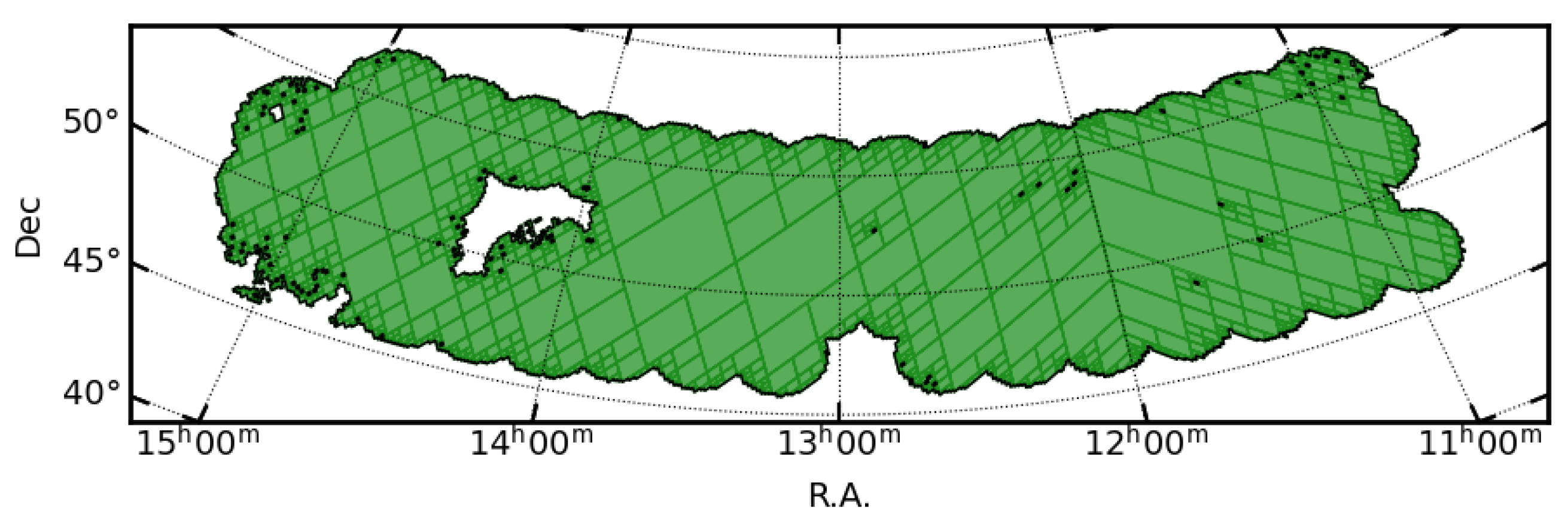
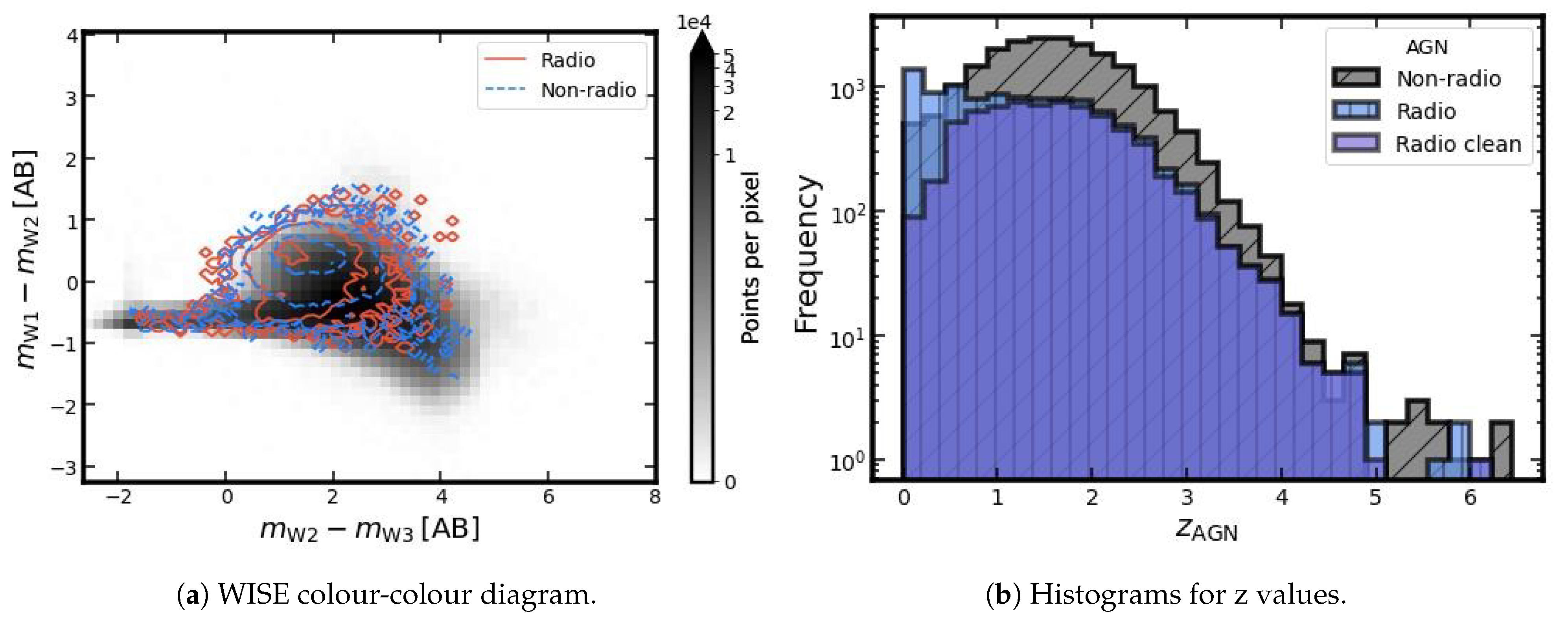
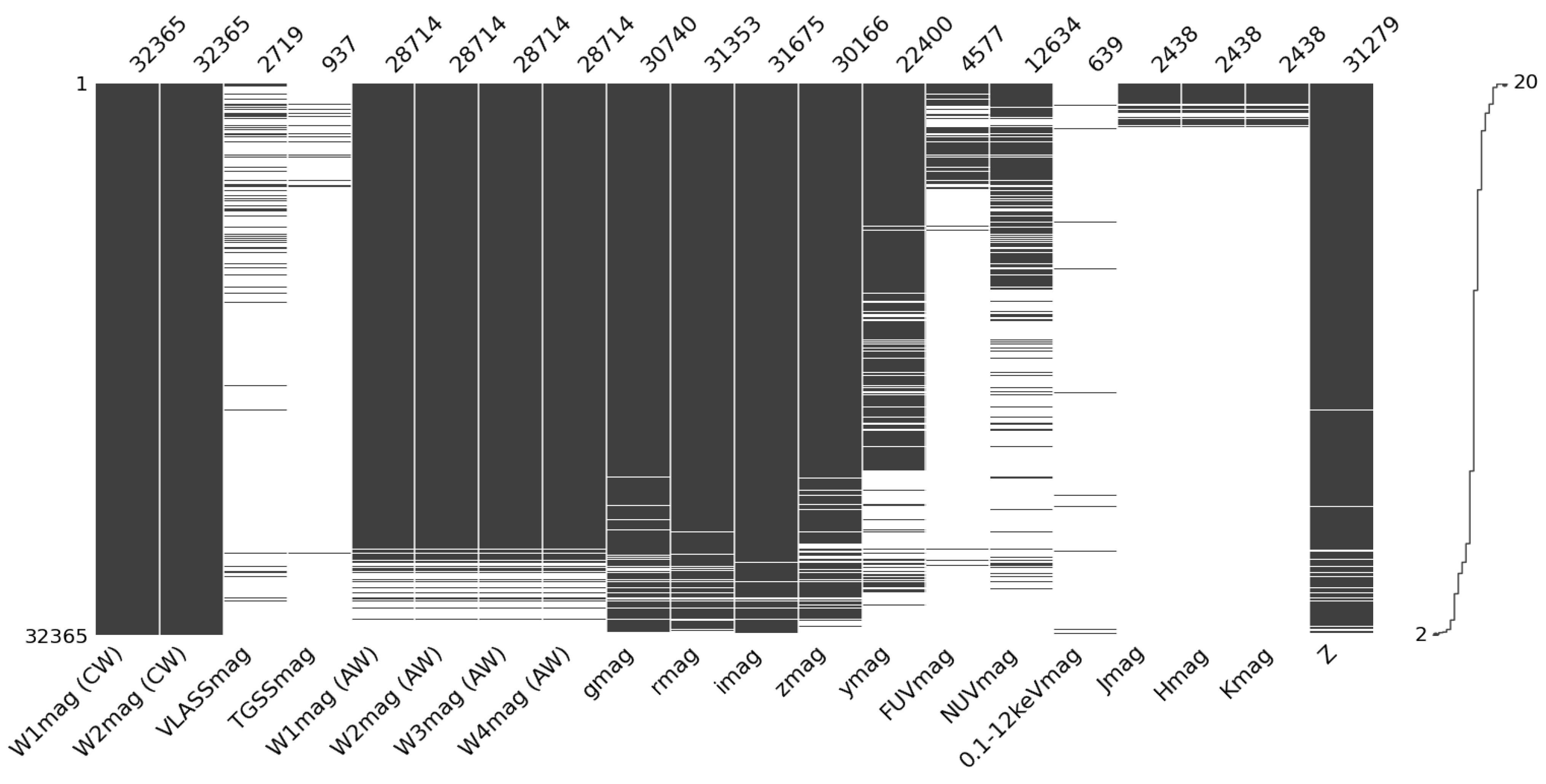
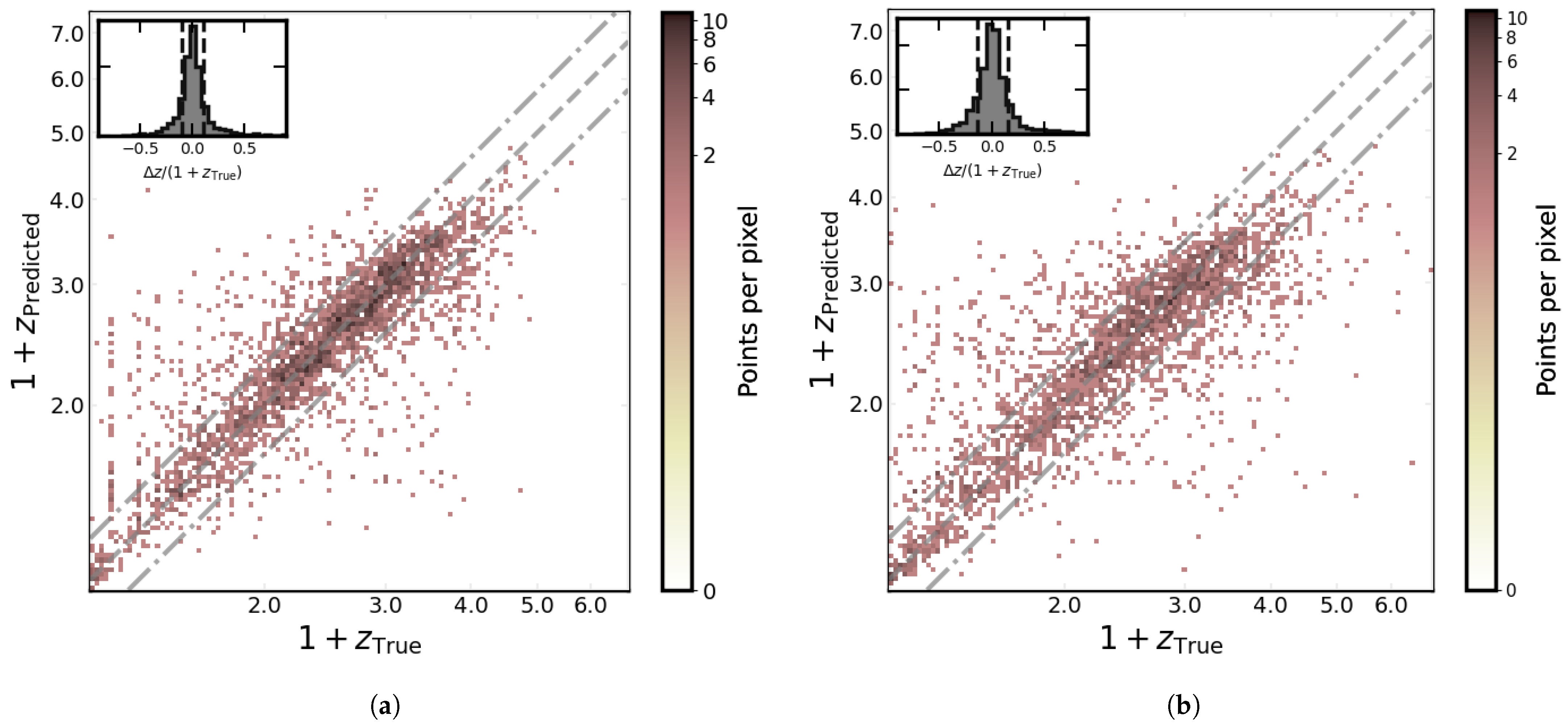
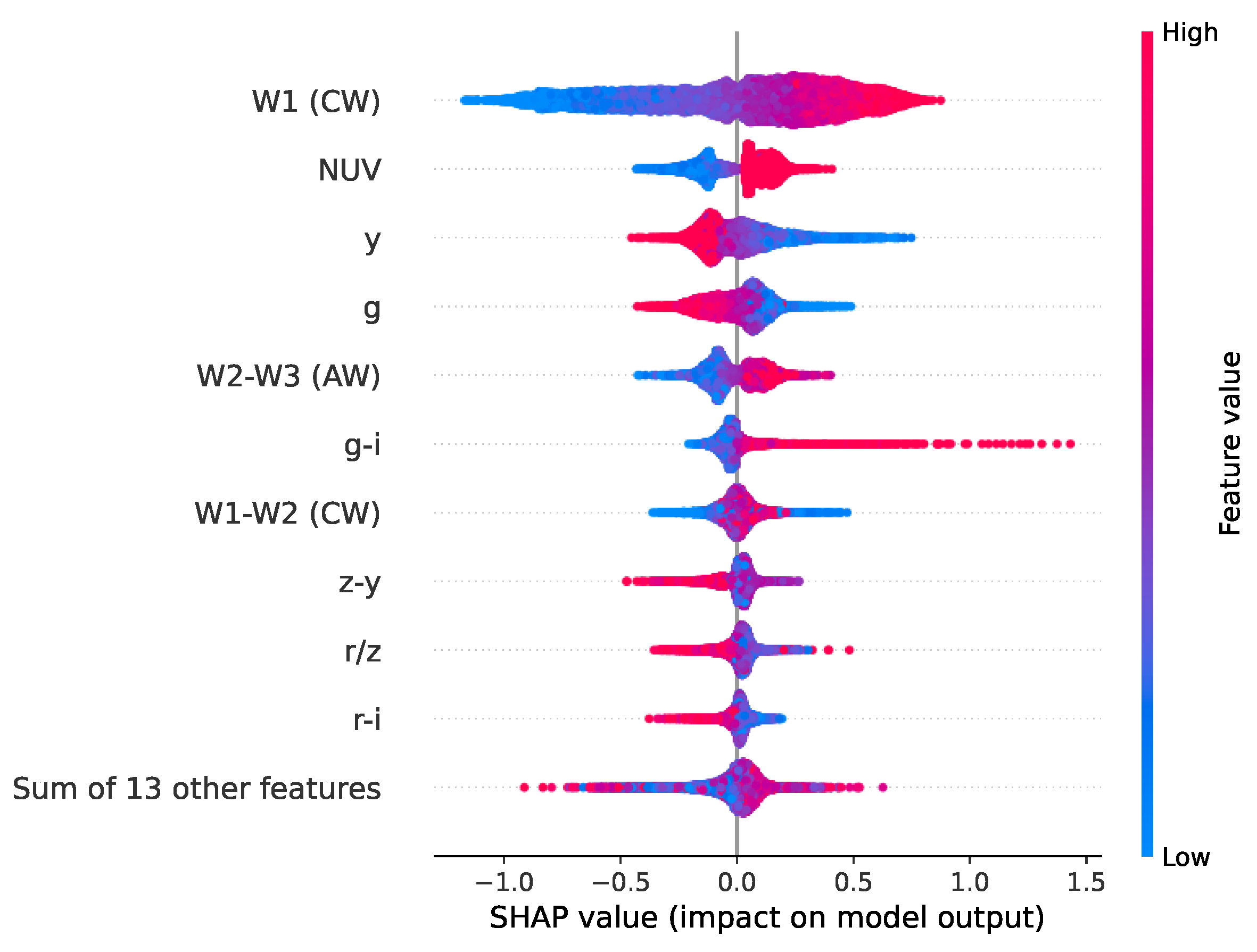
| Survey/Instrument | Bands | Survey/Instrument | Bands |
|---|---|---|---|
| CatWISE2020 | W1, W2 | VLASS | 3.0 GHz |
| AllWISE | W1, W2, W3, W4 | GALEX | FUV, NUV |
| Pan-STARRS | g, r, i, z, y | 2MASS | J, H, K |
| LOFAR | 150 MHz | XMM-NEWTON | 0.2–12 keV |
| GMRT | 150 MHz |
| Random | Extra | CatBoost | LightGBM | XGBoost | Stacked | Stacked | |
|---|---|---|---|---|---|---|---|
| Forest | Trees | Train | Train + Test | ||||
| HETDEX | HETDEX | Stripe 82 | Stripe 82 | |
|---|---|---|---|---|
| Test Set | Validation Set | Test Set | Ananna+17 | |
| Stripe 82 Full | Stripe 82 Match | SDSS KN | SDSS DT | SDSS DL | |
|---|---|---|---|---|---|
| Ananna+17 | Ananna+17 | Curran+2021 | Curran+2021 | Curran+2021 | |
| ⋯ | |||||
| ⋯ | |||||
| ⋯ | |||||
| ⋯ | ⋯ | ⋯ |
| Feature | Importance | Feature | Importance | Feature | Importance |
|---|---|---|---|---|---|
| W1 - W2 (CW) | 87.381 | z - y | 37.084 | FUV - NUV | 11.338 |
| W1 (CW) | 82.759 | W1/W3 (AW) | 33.207 | FUV/K | 8.886 |
| g - i | 70.617 | i/y | 33.081 | FUV | 7.202 |
| g | 55.787 | W2/W4 (AW) | 29.196 | K | 5.484 |
| W2 - W3 (AW) | 53.919 | i - z | 28.647 | J - H | 2.817 |
| r/z | 52.251 | W4 (AW) | 26.392 | J/K | 2.803 |
| y | 49.234 | W3 - W4 (AW) | 24.898 | H - K | 2.771 |
| r - i | 46.451 | NUV | 23.296 |
Publisher’s Note: MDPI stays neutral with regard to jurisdictional claims in published maps and institutional affiliations. |
© 2021 by the authors. Licensee MDPI, Basel, Switzerland. This article is an open access article distributed under the terms and conditions of the Creative Commons Attribution (CC BY) license (https://creativecommons.org/licenses/by/4.0/).
Share and Cite
Carvajal, R.; Matute, I.; Afonso, J.; Amarantidis, S.; Barbosa, D.; Cunha, P.; Humphrey, A. Exploring New Redshift Indicators for Radio-Powerful AGN. Galaxies 2021, 9, 86. https://doi.org/10.3390/galaxies9040086
Carvajal R, Matute I, Afonso J, Amarantidis S, Barbosa D, Cunha P, Humphrey A. Exploring New Redshift Indicators for Radio-Powerful AGN. Galaxies. 2021; 9(4):86. https://doi.org/10.3390/galaxies9040086
Chicago/Turabian StyleCarvajal, Rodrigo, Israel Matute, José Afonso, Stergios Amarantidis, Davi Barbosa, Pedro Cunha, and Andrew Humphrey. 2021. "Exploring New Redshift Indicators for Radio-Powerful AGN" Galaxies 9, no. 4: 86. https://doi.org/10.3390/galaxies9040086
APA StyleCarvajal, R., Matute, I., Afonso, J., Amarantidis, S., Barbosa, D., Cunha, P., & Humphrey, A. (2021). Exploring New Redshift Indicators for Radio-Powerful AGN. Galaxies, 9(4), 86. https://doi.org/10.3390/galaxies9040086






